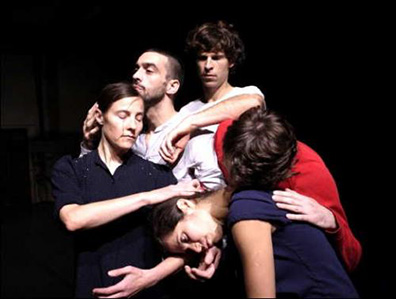
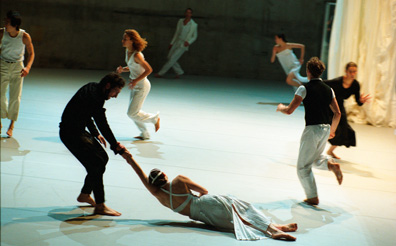
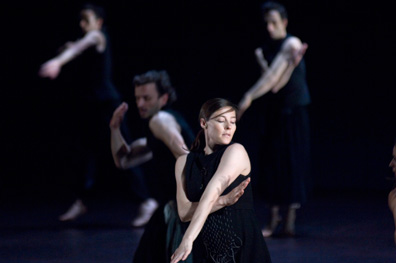
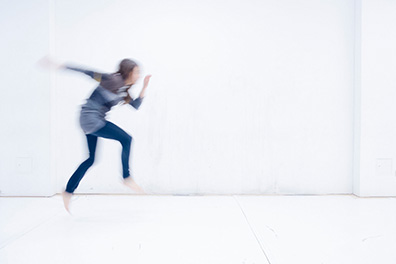
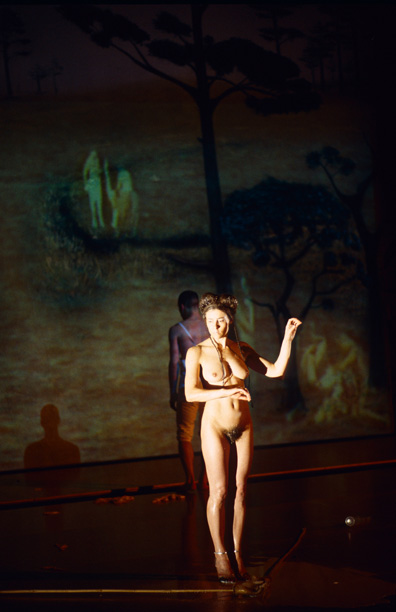
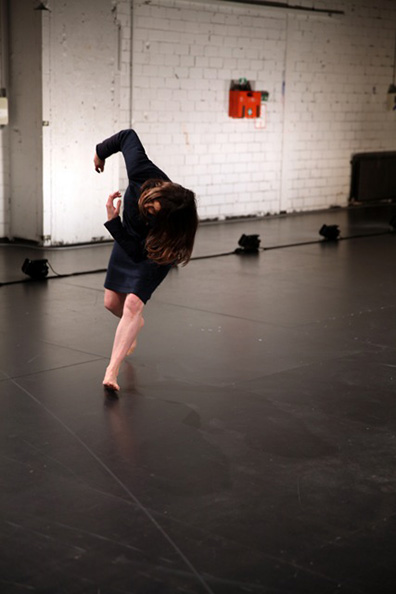
a way of being
Lisa Densem
Oct 26 – Nov 13, 2015
A Way of Being
Over the last few years my work has been focused on research into a particular state of heightened ‘attention’ or way of being that can occur while dancing, improvising or performing. I have been interested in how the emergence of this way of being changes the way a dancer or performer perceives and responds to action around them, and how this, in turn, creates a charged space, which is perceptible to both the person doing and to those watching. We do and our doing seems to come from a place we cannot name. We watch, a person standing for example, and it can suddenly appear as if we had never seen someone standing before. In his essay ‘The Space of Appearance’ it is this kind of charged space that the writer Ric Allsopp seems to be describing, “a space that […] opens up the place of ‘here’, that is momentarily in excess of its condition, that produces epiphanies and visions out of the ordinary.”
When we inhabit this way of being, when we are inside this presence, the way we perceive and move shifts. We open to the many details, intricacies and nuances of what we are, what we do, and what is happening around us. We become projected out of our habitual selves and enter into a concrete relation with the world. When we are inside this presence our bodily appearance and the way movement and the space around us are perceived all appear transformed.
What are the properties of this way of being and the space it creates? How do states of mind and differing attentions affect the way a body, a person or a space is perceived in performance? How can our gestures, movements, actions and the space of the stage, become seeable in the way Allsopp describes? What kinds of ‘beings’ and ‘doings’ and what kinds of strategies can be used to precipitate a jump into another way of moving, seeing and experiencing? Can it be produced or is it something that can only arise, strangely and unpredictably?
In my research I have sought to answer these questions, to find ways to define or describe the qualities or properties of this presence or way of being and to find ways that it has the possibility to appear. In this workshop I want to share my research and practice and explore the many questions it raises. We will seek to embody ourselves in ways that can allow the possibility for opposing or ambiguous readings to exist simultaneously. We will look for ways to be both the materiality of our body and the images that its gestures can project. We will work to inhabit a body consciousness and a mind consciousness both as separate entities and as one.
The workshop will focus on exploring questions of presence and ways of being through different tasks, improvisations, exercises, thought nets, somatic techniques, and theoretical texts gleaned from the myriad sources I have come into contact with over the years (in particular the work of Deborah Hay, Susan Rethorst, Steve Paxton, Avi Grinberg, Keith Hennessey, Nina Martin, Susan Klein, Laurent Chetouane, Jonathan Burrows and many years of yoga practice). How can we bring ourselves into a space where fields of possibility open out before us? What can we do when possibility closes down and it’s all same old, same old? Different attentions awaken different aspects and qualities of presence and different points of access. We will work with our perception of space, time and silence. We will work with attention to the details of our bodily sense – to how we see and feel and hear, to the quality of our touch and our breath, to the tone of our muscles, and to the way we stand. We will work with our perceptions of and relations to others. We will work with the question of being watched or looked at. We will ask how we can remain present under the intensity of an audience’s gaze. We will work alone, together, in small groups, or in pairs. We will watch and be watched. We will share what we see and experience. We will read texts, ask questions and find ways to answer them.
Shifting from one way of perceiving, and one way of being perceived, to another can depend on the smallest detail - the tone of one's body, the timing of a gesture, the direction and quality of one's gaze. This workshop will look at how thoughts, states of mind, attentions, images and the way we hold our body can affect our perception of the world and in turn the world’s perception of us. It will ask how it is possible to create in a performer and a performance space, both a sense of the concreteness of the here and now, and fall through this into a space of imagination and reflection.
––––––––––––––––––––––––––––––––––––––––––––––––––––––––
 Lisa Densem is a New Zealand born dance artist who has been living in Berlin since 1999. Lisa graduated from the NZ School of Dance in 1987 and before her move to Berlin worked in NZ for many years, most notably with the choreographers Douglas Wright and Michael Parmenter. In 1995 Lisa also began teaching and creating her own work and her first large project ‘No Sun, No Rain’ won a NZ choreographic award in 1997. This work led to a stipend to study dance and performance in New York in 1998 where Lisa studied intensively at the Movement Research center, the Klein studio, St Mark’s Church and the Trisha Brown studio. In 1999 Lisa moved to Berlin and began working with the company 'Sasha Waltz and Guests'. She was part of the trilogy series, ‘Koerper’, ‘S’, and ‘Nobody’, and numerous other works and site specific projects with the company. Lisa now works independently and over the last few years has performed with the choreographers Jana Unmüssig, Hanna Hegenscheidt and Laurent Chetouane. She is also featured in the documentary ‘Virtuosi’ by the choreographer and film maker, Sue Healey. She continues to develop her own work and in 2013 created ‘We Have Been There’ for the NZ dance company ‘Footnote’. In 2014 Lisa graduated from the MA SODA programme at the UDK in Berlin.
Lisa Densem is a New Zealand born dance artist who has been living in Berlin since 1999. Lisa graduated from the NZ School of Dance in 1987 and before her move to Berlin worked in NZ for many years, most notably with the choreographers Douglas Wright and Michael Parmenter. In 1995 Lisa also began teaching and creating her own work and her first large project ‘No Sun, No Rain’ won a NZ choreographic award in 1997. This work led to a stipend to study dance and performance in New York in 1998 where Lisa studied intensively at the Movement Research center, the Klein studio, St Mark’s Church and the Trisha Brown studio. In 1999 Lisa moved to Berlin and began working with the company 'Sasha Waltz and Guests'. She was part of the trilogy series, ‘Koerper’, ‘S’, and ‘Nobody’, and numerous other works and site specific projects with the company. Lisa now works independently and over the last few years has performed with the choreographers Jana Unmüssig, Hanna Hegenscheidt and Laurent Chetouane. She is also featured in the documentary ‘Virtuosi’ by the choreographer and film maker, Sue Healey. She continues to develop her own work and in 2013 created ‘We Have Been There’ for the NZ dance company ‘Footnote’. In 2014 Lisa graduated from the MA SODA programme at the UDK in Berlin.
––––––––––––––––––––––––––––––––––––––––––––––––––––––––
photos:
Oliver Fantitsch
Bernd Uhlig
Sebastian Bolesch
Sven Hagolani
Bernd Uhlig
Alain Roux
